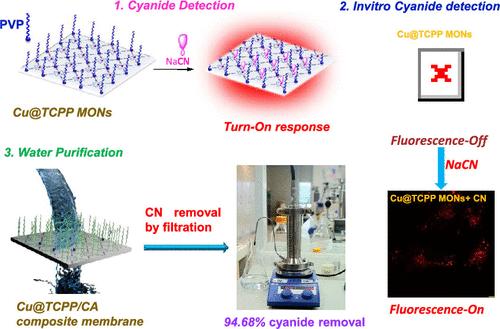Cu-TCPP金属有机纳米片嵌入薄膜复合膜增强氰化物检测和去除:一种多功能的水处理和环境安全方法
IF 8.2
2区 材料科学
Q1 MATERIALS SCIENCE, MULTIDISCIPLINARY
引用次数: 0
摘要
氰化物剧毒,广泛的工业使用对环境构成严重威胁。检测和过滤水中氰化物的有效材料是迫切需要的。本研究介绍了一种利用Cu-TCPP (TCPP = o-四(4-羧基苯基)卟啉)金属有机纳米片(MONS)嵌入薄膜复合膜的新方法,为氰化物检测和过滤提供了一种多功能解决方案。超薄Cu-TCPP MONs采用表面活性剂辅助方法合成,具有高度可接近的金属中心,增强氰化物相互作用和检测。该膜是用Cu-TCPP蒙斯改性醋酸纤维素(CA)制备的,具有优异的除氰性能。6% Cu-TCPP/CA膜的纯水渗透率提高了2.3倍,氰化物去除效率为94.68%,显著优于0% Cu-TCPP/CA原始膜(纯水渗透率(PWP) = 380.83 L m-2 h-1 bar-1;CN -去除率= 5.01%)。这是文献中首次报道利用膜技术检测和去除水中的CN -。除去除效率外,Cu-TCPP MONs还显示出卓越的检测能力,计算出的检测限为1.76 × 10-7 M,超过了世界卫生组织(WHO)和美国环境保护署(EPA)对水中氰化物水平的安全标准。此外,Cu-TCPP MONs是一种具有良好细胞活力的生物显像剂,用于检测MiaPaCa-2细胞中的CN -,检测浓度低至0.1 ppm。本文章由计算机程序翻译,如有差异,请以英文原文为准。

Cu-TCPP Metal–Organic Nanosheets Embedded Thin-Film Composite Membranes for Enhanced Cyanide Detection and Removal: A Multifunctional Approach to Water Treatment and Environmental Safety
Cyanide is highly toxic, with widespread industrial use posing serious environmental risks. Effective materials for detecting and filtering cyanide from water are urgently needed. This study introduces a novel approach utilizing Cu-TCPP (TCPP = o-tetra(4-carboxyphenyl)porphine) metal–organic nanosheets (MONS) embedded in thin-film composite membranes, offering a multifunctional solution for cyanide detection and filtration. Ultrathin Cu-TCPP MONs were synthesized using a surfactant-assisted method featuring highly accessible metal centers that enhance cyanide interaction and detection. The membranes, developed by modifying cellulose acetate (CA) with Cu-TCPP MONs, demonstrated exceptional performance for cyanide removal. The 6% Cu-TCPP/CA membrane exhibited a 2.3-fold increase in pure water permeability and achieved a cyanide removal efficiency of 94.68%, significantly outperforming the pristine 0% Cu-TCPP/CA membrane (Pure Water Permeability (PWP) = 380.83 L m–2 h–1 bar–1; CN– removal = 5.01%). This is the first report describing the detection and removal of CN– in water using the membrane technique in literature. In addition to its removal efficiency, the Cu-TCPP MONs showed remarkable detection capabilities, with a calculated limit of detection of 1.76 × 10–7 M, surpassing World Health Organization (WHO) and United States Environmental Protection Agency (EPA) safety standards for cyanide levels in water. Additionally, Cu-TCPP MONs, a bioimaging agent with excellent cell viability, were deployed to detect CN– in MiaPaCa-2 cells, detecting concentrations as low as 0.1 ppm.
求助全文
通过发布文献求助,成功后即可免费获取论文全文。
去求助
来源期刊

ACS Applied Materials & Interfaces
工程技术-材料科学:综合
CiteScore
16.00
自引率
6.30%
发文量
4978
审稿时长
1.8 months
期刊介绍:
ACS Applied Materials & Interfaces is a leading interdisciplinary journal that brings together chemists, engineers, physicists, and biologists to explore the development and utilization of newly-discovered materials and interfacial processes for specific applications. Our journal has experienced remarkable growth since its establishment in 2009, both in terms of the number of articles published and the impact of the research showcased. We are proud to foster a truly global community, with the majority of published articles originating from outside the United States, reflecting the rapid growth of applied research worldwide.
 求助内容:
求助内容: 应助结果提醒方式:
应助结果提醒方式:


